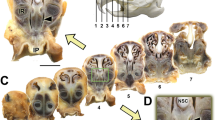Summary
Primary olfactory and vomeronasal projections as well as the pathway of the nervus terminalis were studied in 10 representative species of salamandrid and plethodontid salamanders by means of injections of horseradish peroxidase and examination of whole-mount preparations. Olfactory projections are very similar in the different urodeles, but vomeronasal projections differ in shape and number of termination fields. Whereas the direct-developing Plethodontini and Bolitoglossini reveal only one or two fields, the salamandrid species and the members of the plethodontid tribes Desmognathinae and Hemidactyliini, all possessing an aquatic larval stage, exhibit several vomeronasal projection fields. In all species examined centrifugal axons of the nervus terminalis leave the olfactory projection area ventrocaudally and terminate in the preoptic region and the hypothalamus.
Similar content being viewed by others
Abbreviations
- COM. ANT :
-
commissura anterior
- DGL :
-
displaced glomeruli
- HY :
-
hypophysis
- HYTH :
-
hypothalamus
- LF :
-
lateral fibers of the nervus terminalis
- ME :
-
medulla oblongata
- MF :
-
medial fibers of the nervus terminalis
- Nt :
-
nervus terminalis
- Npo :
-
nucleus praeopticus
References
Bartheld CS von, Meyer DL (1986) Tracing of single fibers of the nervus terminalis in the goldfish brain. Cell Tissue Res 245:143–158
Bertmar G (1981) Evolution of vomeronasal organs in vertebrates. Evolution 35:359–366
Broman I (1920) Das Organon vomero-nasale Jacobsoni — ein Wassergeruchsorgan! Anat Hefte 58:143–191
Brown CW (1968) Additional observations on the function of the nasolabial grooves of plethodontid salamanders. Copeia 4:728–731
Crapon de Caprona M-D, Fritzsch B (1983) The development of the retinopetal nucleus olfacto-retinalis of two cichlid fishes as revealed by horseradish peroxidase. Dev Brain Res 11:281–301
David RS, Jaeger RG (1981) Prey location through chemical cues by a terrestrial salamander. Copeia 2:435–440
Dawley EM (1984) Recognition of individual sex and species odours by salamanders of the Plethodon glutinosus —Plethodon Jordani complex. Anim Behav 32:353–361
Demski LS, Northcutt RG (1983) The terminal nerve: a new chemosensory system in vertebrates? Science 220:435–437
Dubois-Dauphin M, Tribollet E, Dreifuss JJ (1981) Relations somatotopiques entre la muqueuse olfactive et le bulbe olfactif chez le triton. Brain Res 219:269–287
Fritzsch B (1980) Retinal projections in European Salamandridae. Cell Tissue Res 213:325–341
Forrester DC (1979) Homing to the nest by female mountain dusky salamanders (Desmognathus ochrophaeus) with comments on the sensory modalities essential to clutch recognition. Herpetologica 35:330–335
Graziadei PPC, Monti-Graziadei GA (1976) Olfactory epithelium of Necturus maculosus and Ambystoma tigrinum. Neurocyt 5:187–197
Herrick CJ (1909) The nervus terminalis (nerve of Pinkus) in the frog. J Comp Neurol 37(3):175–190
Herrick CJ (1921) The connections of the vomeronasal nerve, accessory olfactory bulb and amygdala in Amphibia. J Comp Neurol 33(1):213–280
Jaeger RG, Gergits WF (1978) Intraand interspecific communication in salmanders through chemical signals on the substrate. Anim Behav 27:150–156
Johnston JB (1913) Nervus terminalis in reptiles and mammals. J Comp Neurol 23:9–120
Kleeberger SR, Werner IK (1982) Home range and homing behavior of Plethodon cinereus in Northern Michigan. Copeia 2:409–415
Lindquist SB, Bachmann MD (1982) The role of visual and olfactory cues in the prey catching behavior of the tiger salamander Ambystoma tigrinum. Copeia 1:81–90
Luthardt G, Roth G (1983) The interaction of the visual and the olfactory system in guiding prey catching behavior in Salamandra salamandra. Behavior 83:69–79
Mackay-Sim A, Nathan MH (1984) The projection from the olfactory epithelium to the olfactory bulb in the salamander Ambystoma tigrinum. Anat Embryol 170:93–97
McKibben PS (1911) The nervus terminalis in urodele Amphibia. J Comp Neurol 21:261–309
Münz H, Claas B, Stumpf WE, Jennes L (1982) Centrifugal innervation of the retina by luteinizing hormone releasing hormone (LHRH). Immunreactive telencephalic neurons in teleostean fishes. Cell Tissue Res 222:313–323
Parsons TS (1967) Evolution of the nasal structure in the lower tetrapods. Am Zool 7:397–413
Roth G (1976) Experimental analysis of the prey catching behavior of Hydromantes italicus (Amphibia, Plethodontidae). J Comp Physiol 109:47–58
Roth G, Wake DB (1985) The structure of the brainstem and cervical spinal cord in lungless salamanders (family Plethodontidae) and its relation to feeding. J Comp Neurol 241:99–110
Scalia F (1976) Structure of the olfactory and accessory olfactory systems. In: Llinas R, Precht W (eds) Frog Neurobiology. Springer, Berlin Heidelberg New York, pp 213–233
Schuch K (1934) Das Geruchsorgan von Triton alpestris. Zool Jb Anat u Onto 59:69–134
Springer AD (1983) Centrifugal innervation of goldfish retina from ganglion cells of the nervus terminalis. J Comp Neurol 214:404–415
Uva B, Deplano S (1983) Olfactory structures in Hydromantes italicus: a morphological basis of a particular prey catching behavior. Bolletino Zool 50(1–2):57–62
Wake DB (1966) Comparative osteology and evolution of lungless salamanders, family Plethodontidae. Memoirs of the Southern California Academy of Sciences vol 4:1–111
Wirsig CR, Getchell TV (1986) Amphibian terminal nerve: distribution revealed by LHRH and ACHE markers. Brain Res 385:10–21
Author information
Authors and Affiliations
Rights and permissions
About this article
Cite this article
Schmidt, A., Naujoks-Manteuffel, C. & Roth, G. Olfactory and vomeronasal projections and the pathway of the nervus terminalis in ten species of salamanders. Cell Tissue Res. 251, 45–50 (1988). https://doi.org/10.1007/BF00215445
Accepted:
Issue Date:
DOI: https://doi.org/10.1007/BF00215445




